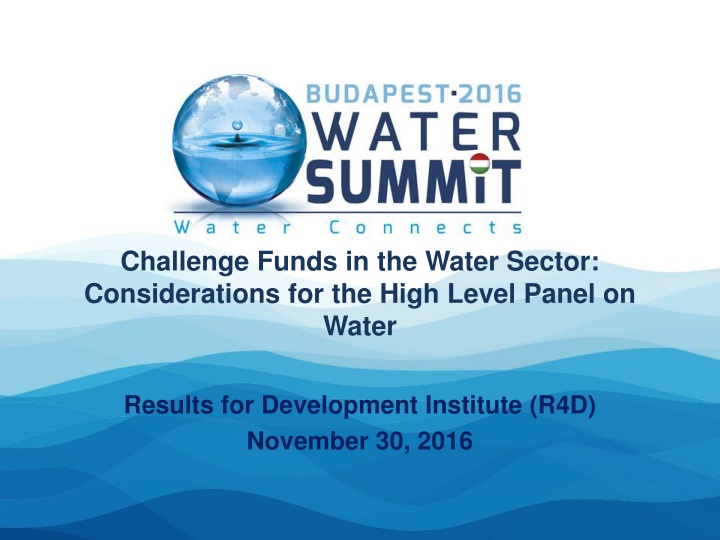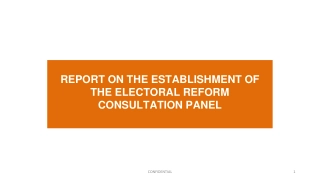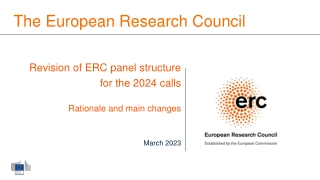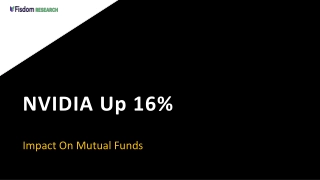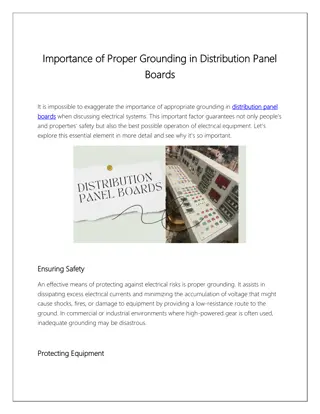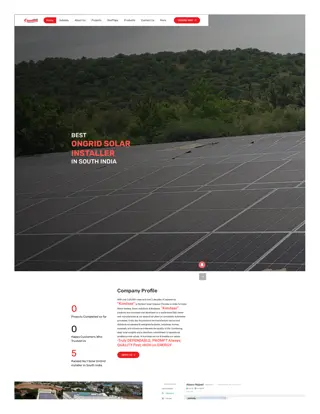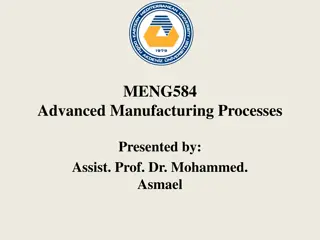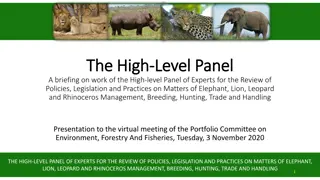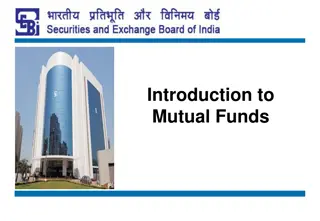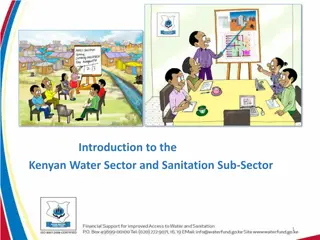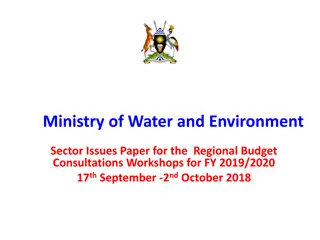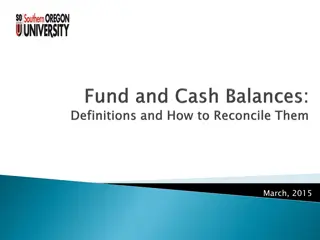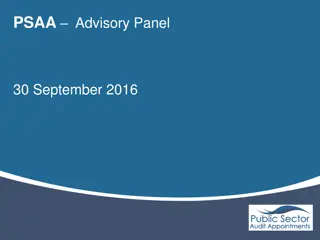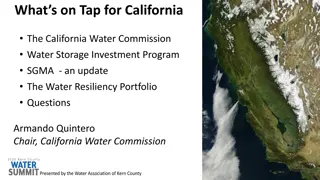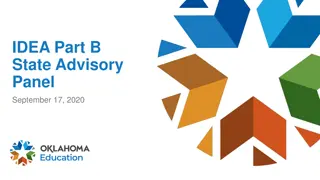Challenge Funds in the Water Sector: Considerations for the High-Level Panel on Water
This content addresses the establishment of challenge funds in the water sector and provides insights for the High-Level Panel on Water Results for Development Institute (R4D). The discussion focuses on key considerations and strategies relevant to leveraging resources for sustainable development and enhancing water sector innovations. It emphasizes the importance of effective fund utilization and collaboration to address challenges in the water sector and achieve positive outcomes.
Download Presentation

Please find below an Image/Link to download the presentation.
The content on the website is provided AS IS for your information and personal use only. It may not be sold, licensed, or shared on other websites without obtaining consent from the author.If you encounter any issues during the download, it is possible that the publisher has removed the file from their server.
You are allowed to download the files provided on this website for personal or commercial use, subject to the condition that they are used lawfully. All files are the property of their respective owners.
The content on the website is provided AS IS for your information and personal use only. It may not be sold, licensed, or shared on other websites without obtaining consent from the author.
E N D
Presentation Transcript
Challenge Funds in the Water Sector: Considerations for the High Level Panel on Water Results for Development Institute (R4D) November 30, 2016
The High Level Panel on Water Convened by UN SG Ban Ki-moon and World Bank President Dr. Jim Yong Kim Eleven Heads of State and Government and one Special Adviser Purpose: provide the leadership required for comprehensive, inclusive and collaborative action to improve (i) water supply and sanitation and (ii) water resources management. Announced at WEF/Davos in January 2016 A time-bound initiative, established for an initial period of two years. The core focus of the Panel is: Sustainable Development Goal (SDG) 6 Ensuring the availability & sustainable management of water & sanitation for all On 21 September 2016 the HLPW called for a fundamental shift in the way the world looks at water with: An Action Plan for a new approach to water management HLPW commits to action and calls upon Heads of State and Government to do so too.
What we were asked to do Do a stocktaking exercise of existing challenge-style funding and innovation mechanisms in the water sector, focusing on: Three pre-identified priorities Efficiency of agricultural water use Safe drinking water and sanitation in remote rural areas, especially for women and girls Water data and others that emerge from the analysis Give recommendations on whether/how the HLPW should support or stand up new challenge-style funds, considering: Political, operational, financial aspects Possible partners Potential for achieving breakthroughs and commercialization
How we did it Interviews with 17+ experts and stakeholders With backgrounds on challenge funds and water issues Researchers, funders, practitioners, NGOs and technical groups Broad literature review Resulting in focus on 18 key documents Published and unpublished Research outputs, evaluations, thought pieces, etc. Analysis of 24+ existing challenge funds Water-related and water-adjacent Identification of innovation deserts, objectives, and structure And as we pulled all this together we drew on our own experience On challenge funds and water issues
Existing water challenges landscape Water-related challenge funds areas of focus are spread across: Water data: 3 Rural water and sanitation: 9 Agricultural water use: 4 Urban water and sanitation: 2 Water governance: 3 Other: 4 Many concentrate on: Social and technical solutions (not policy or regulatory reform) Providing one year or less of funding to their grant recipients The amounts they provide vary considerably: <US$50,000: 7 US$50,000-250,000: 11 >US$250,000: 7 The stage of development they support (early, middle, or late) varies too Some (11 of 24) support multiple stages
The sector needs fresh thinking Many of the same approaches (and technologies) have been used in the water sector for decades, yet the same problems persist Investment in innovation is small in the water sector compared to other sectors Estimated 1-2% of startup/early-stage investment is water-related The apparent need for innovation in the sector is high, especially in financing, policy, and scaling up. Challenge funds create an opportunity to inject fresh thinking and encourage unlikely players to participate in shaking up sectors
But beware of silver bullet one-off challenges One-off idea factories that lack clear pathways to implementation often fail. Failure to secure meaningful buy-in from key stakeholders (especially government) often dooms short-term challenge mechanisms. Over engineering of contests/challenges often edges out resource-strapped (but innovative) applicants such as local SMEs and CSOs. One-off challenges often ignore existing policy and enabling environment factors, which limits impact.
Our recommendation: A Water Sector Innovation Engine Pillar #1: The HLPW should advocate for greater investment in innovation in the water sector through Pillar #2: a multi-stakeholder mechanism to finance continual innovation in the water sector . Pillar #3: that embraces best practices in challenge fund design and implementation, and... Pillar #4: focuses initial challenges on water data, water governance, urban and rural water and sanitation, and water for agriculture.
Pillar #1: HLPW Advocacy Rather than stand up and run a challenge fund itself, the best role for the HLPW is to: Advocate for greater investment in innovation in the water sector Convene experts and leaders and galvanize support for challenge funds that address key water issues Persuade appropriate partners to start, run and finance challenge funds that address key water issues
Pillar #2: Multi-stakeholder Mechanism To channel and coordinate multiple water challenges over time, the HLPW should consider a partnership approach comprising a steering committee, implementing partner(s), and marketing partners a partnership we dub the Water Sector Innovation Engine. Key characteristics of the Engine: A stretch target for its eventual size (e.g. $25 million) drawing financing from HLPW member countries, philanthropies, aid donors, & private sector water actors (e.g. Coke, Pepsi, Nestle) Two to three funding windows, for early stage, proof-of-concept innovations (up to $250,000) and for tested innovations ready for scale (can absorb up to an additional $1m). Can run multiple water challenges in parallel
Pillar #2: Multi-stakeholder Mechanism (contd) Recommendations for Engine steering committee: Role of steering committee Identify important challengeable water issues Push for follow through and financial investment, especially from private sector Advocate for best practices in challenge fund design Advocate for strong monitoring and evaluation on the effectiveness and impact of challenge-style funding mechanisms Steering committee members Challenge fund donors Leading water experts Implementing partner (runs the water challenges themselves (ex. GIF, GCC, Gates, etc.) and acts as Engine secretariat) Marketing partner (ensures high visibility and participation for the Challenges)
Pillar #2: Multi-stakeholder Mechanism (contd) Recommendations for Engine implementing partner: Partnering with an entity that has the necessary infrastructure for, and a good track record in, managing challenge funds has many advantages: Easy to mount multiple challenges on different topics, simultaneously or sequentially Possible implementing partners: Global Innovation Fund, Grand Challenges organizations (Canada, Gates), UK/DfID (and some of its service providers) The primary alternative is risky: a one-off effort that creates its own, loose platform around a sole issue (e.g. global polio campaign) can be more costly, difficult, labor-intensive, and time- consuming to set up and sustain.
Pillar #2: Multi-stakeholder Mechanism (contd) Recommendations for Engine marketing partner: Promotes Engine challenges in target regions and/or globally through mixed media outreach and thought leadership. Develops creative ways of soliciting participation from non-usual suspects, including small and medium enterprises, domestic non-state actors and civil society, and public-private partnerships (particularly at the local level). Drives a higher volume of higher-quality applications (especially if coupled with an application and review process that is itself beneficial to participants)
Pillar #3: Embracing challenge fund best practice The HLPW can advocate for best practices in Engine challenge fund design and implementation, including: Addressing a specific problem, especially one that would benefit from added attention Incorporating learning and collaboration into the application and review process Embracing multi-year timeframes and staged funding opportunities Aligning the challenge fund with national priorities Developing opportunities for investment and adoption post-challenge fund Investing in robust and long-term evaluations Investing in marketing making visibility and prestige an incentive to apply Providing technical support as well as financial support
Pillar #4: Possible focal areas for initial Engine challenges (cont.) Consider focusing the Engine s initial challenges on: Water data* Water governance Safe drinking water and sanitation in rural areas* Emphasis on effective service delivery and uptake of existing solutions. Safe drinking water and sanitation in urban areas Agricultural water use* Water data and water governance are complex problems that the HLPW and the Engine may be uniquely positioned to influence given strengths in political access and power to convene diverse actors. *Priorities identified in HLPW Action Plan. Others came out as key themes in interviews and literature review.
Pillar #4: Possible focal areas for initial Engine challenges Tools for bottom-up reporting on water access and quality issues designed to hold public and private utilities to accountable and encourage responsiveness Water Data Technology to collect water resource data for use by farmers, local governments, and businesses Improved public water data systems that take advantage of satellite-based data and crowdsourced data from citizens, and platforms that link different systems Water tariffs or public financing approaches that get closer to covering actual O&M costs, while protecting the poorest and most vulnerable populations Water Governance Better regulations around water and land rights that promote access to water and sanitation for all Policy or regulatory solutions for addressing intermittent water supply in urban areas Appropriate sanitation and sewerage technologies for densely population urban areas Rural & urban water supply and sanitation Business models and distribution channels that promote uptake of existing water purification technologies Fecal sludge management systems for rural and urban areas Effective monitoring solutions (technological or business model solutions) for water pumps to reduce downtime due to repairs and maintenance Solutions around distribution and uptake of water efficiency and conservation tools/practices for agriculture Water for Agriculture
Narrowing the options: focal area scoring Potential for Implementation Partnerships Political Feasibility Operational Tractability Financial Requirements Potential for Breakthrough Plays to HLPW Strengths Water data Accountability tools for citizens to collect, report and solicit responses from private or public utilities on water access and quality Medium Low Low Low High Medium Technology to collect water resource data for use by farmers, local governments, and businesses Improved public water data systems that take advantage of satellite-based data and crowdsourced data from citizens, and platforms that link different systems Policies and regulations Medium Medium High High High Medium Medium Low High High High High Water tariffs or public financing approaches that get closer to covering actual O&M costs, while protecting the poorest and most vulnerable populations Low Low High High Low High Better regulations around water and land rights that promote access to water and sanitation for all Low Medium Low High Low High Policy or regulatory solutions for addressing intermittent water supply in urban areas Rural & urban water supply and sanitation High High Medium High High Medium Appropriate sanitation and sewerage technologies for densely population urban areas Medium Medium High Medium High Medium Business models and distribution channels that promote uptake of existing water purification technologies Fecal sludge management systems for rural and urban areas Medium Low High High Medium Medium High Low High High Medium Low Effective monitoring solutions (technological or business model solutions) for water pumps to reduce downtime due to repairs and maintenance in rural areas Water for Agriculture High Medium High Medium High Low Solutions around distribution and uptake of water efficiency and water conservation tools/practices for agriculture Low Medium Medium High Low Low
Pillar #4: Possible focal areas for initial Engine challenges (cont.) Water data Examples of potential solutions to surface through a challenge: Improved public water data systems that take advantage of satellite-based data and crowdsourced data from citizens, and platforms that link different systems Technology to collect water resource data for use by farmers, local governments, and businesses Opportunity for addressing issues with collective action, for example through an initiative such as Global Forest Watch the result of a partnership between dozens of actors, including the World Resources Institute and Google, to make satellite data on deforestation available and usable.
Pillar #4: Possible focal areas for initial Engine challenges (cont.) Water governance Examples of potential solutions to surface through a challenge: Water tariffs or public financing approaches that get closer to covering actual O&M costs, while protecting the poorest and most vulnerable populations Better regulations around water and land rights that promote access to water and sanitation for all Opportunity to become a leader in burgeoning experiments in challenge funds as an instrument to reimagine the way municipalities regulate and finance water services. Example: Sanitation Challenge for Ghana is an initiative of DfID open to Metropolitan, Municipal, and District Assemblies in Ghana to bring transformational changes to city-wide sanitation services in urban areas. Example: Imagine H2O s California Water Policy Challenge is in its second round, attracting applicants from academia, the private sector, government entities and NGOs to develop actionable policy recommendations to drive adoption of water technologies by CA s cities, farms and industries.
Thank you! David DeFerranti, ddeferranti@r4d.org Emily Endres, eendres@r4d.org
List of Water-Related Challenge Funds Name Supporting Agency 2017 Water Data Challenge Imagine H2O, Wells Fargo, Suez, TetraTech GFDRR Challenge Fund Global Facility for Disaster Recovery and Reduction, DfID Securing Water for Food: A Grand Challenge for Development USAID, Sida, Netherlands, South Africa CGIAR Challenge Program on Water and Food CGIAR, AusAID, European Commission, Sida, DANIDA, Swiss, GIZ Open IDEO: How might we use market based approaches to expand water and sanitation solutions? IDEO, Water.org Online Innovation Challenge VIA Water, Aqua for All, Africa Funded, UNESCO-IHE Big Data Innovation Challenge World Bank Global Giveback Challenge Series Innocentive, Global Giving, Rockefeller Foundation Girl Power Awards Dasra, USAID, DSP Blackrock Investment Managers, Piramal Foundation Reinvent the Toilet Challenge Gates Grand Challenges Research Princeton University Global Innovation Fund DfID, USAID, Omidyar, Sida, Australian DFAT Swedish Agency for Economic and Regional Growth Swedish Agency for Economic and Regional Growth Funding Innovation for Business in Africa Alliance for Green Revolution in Africa, Australia, Canada, Denmark, Netherlands, Sweden, UK, CGAP, IFAD XPRIZE High Net Worth Individuals, Tata Group, Australian DFAT Dreampipe Challenge Ideas to Impact, DfID Sanitation Challenge for Ghana Ideas to Impact, DfID WASH for Life Development Innovation Ventures (USAID) Stars in Global Health Grand Challenges Canada Novel Enabling Tools and Models Supporting Development of Interventions for Enteric Disruption Grand Challenges Explorations Labor Saving Strategies and Innovations for Women Smallholder Farmers Grand Challenges Explorations Create the Next Generation of Sanitation Technologies Grand Challenges Explorations The Schindler Global Award 2017 for Young Designers Improving mobility systems in Sao Paolo Schindler Group, ETH Zurich Mawazo Challenge Human Development Innovation Fund, UKAID, Palladium CA Water Policy Challenge Imagine H2O
Literature Review Bibliography Challenge Funds in International Development Research Paper, Tripleline Beyond prizes, hackathons and contests: better ways to support innovation in international development, John Feighery, mWater Understanding Challenge Funds, ODI Meeting the challenge: How can enterprise challenge funds be made to work better?, EPS-PEAKS working paper Challenge funds as private sector development tools: progress and potential, KPMG Swedish experiences of challenge funds: case of Innovations Against Poverty, Sida Giving enterprise challenge funds a fighting chance, Dev Policy Blog Exploding the myth of challenge funds, a start at least , David Elliott The Springfield Centre Do challenge funds work or is the Emperor really naked?, The Practitioner Hub for Inclusive Business Enterprise challenge funds for development: rationales, objectives, approaches, Development Policy Centre Discussion Paper Challenging the Challenge Fund!, CHMI Can innovation prizes help address water and sanitation challenges? Review of umbrella fund evaluation focusing on challenge funds, Tripleline Measuring Results in Challenge funds: practical guidelines for implementing the DCED standard, DCED DCED Webinar measuring results in challenge funds, DCED The Evaluation of the challenge fund innovations against poverty, Sida DfID Civil Society Challenge Fund, Final Evaluation, IOC PARC Summative Evaluation & International Expert Panel Review, Grand Challenges Canada
